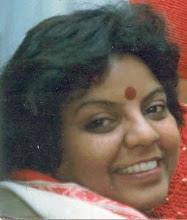

The book on Shuvaprasanna goes far beyond art for the coffee table, says Nirupama dutt
A Book about an artist is the most in thing these days. The past few years have seen quite a few brought out glossy and well bound. Well, a share of contemporary Indian art for the coffee table. But let some of them not just be condemned to decorate the coffee table as men and women (why just women dear T.S.Eliot?) come and go talking of Michaelangelo open some of these books what opens is a world far beyond pretty pictures and the trappings of a 21st century boudoir. One of these is a book on a Calcutta artist who belongs to the generation of the Seventies and it is called: SHUVAPRASANNA-Vision: Reality and Beyond. Published by Art Indus, it speaks to us of our times with a vision which has the power to look before and after. This essentially made so by the subject who makes the book.
The response to Shuvaprasanna's work is not always one of adulation. An invite to his recent show inh the Capital had an art critic moaning, ``Oh! Please, not more crows.'' Yet he remains one of the foremost painters of his generation being as old as the Independence of the country. To know why these crows one must got to the very beautiful and pointed foreword by Samik Bandyopadhyay to the book. He described Shuvaprasanna as a product of the Seventies as they were lived and experienced in Calcutta and goes on to say: ``What Shuvaprasanna gathers from the post-seventies wasteland is the sense of a crumbling space with an accumulation of signs of decay and exhaustion, and signs of a difficult life emerging out of a cityscape left in shambles.''
A little onto the making of Shuvaprasanna, who is often referred to as the artist with whom the Nobel Guenter Grass stays in Calcutta, was a child prodigy in times when child prodigies were not so common nor either their pushy parents as of today. In a rather simple and unpretentious account of his life and art, the author of the book, Chitropala Mukherjee, takes us to the beginnings. Born to a conservative professional Bhatpara family, he liked to sketch his father's patients when hardly four. This led to his painting portraits of politicians and ambassadors. The family was quite proud to have him photographed with President Rajendra Prasad, USSR president Voroshilov or the American ambassador to India in late Fifties. But when it came to take up art as a vocation, father frowned. Shuvaprasanna had his way and a patch-up was to come about later. He graduated from the Indian College of Art a d Draughtsman ship in 1969.
Chitropala writes thus of the times which shaped Shuvaprasanna: ``Pete Seeger strummed his guitar and sang,
Where have all the flowers gone? To rapt audiences in the Park Cireus Maidanin Caleutta, a popular site of political rallies. Allen Ginsberg was well settled in Calcutta smoking pot and writing poetry. There was energy commitment, fire and idealism. Politics was still respected and taken seriously. Poets, painters, writers, art critics and creative minds met in euphemistically named coffee houses (New York Soda Fountain!) and talked fast and furious over cups and cups of tea…''
When Shuvaprasanna started his Lament series in 1970/71, these were described as grim. As grim as Mrinal Sen's film Calcutta 71 was and Sen chose a canvas from these series for his film. From lament to the Crows and to his recent un-iconic icons, Shuvaprasanna has kept his individuality without allowing himself to be labeled. This journey of images through dream and reality has evolved in different ways and Bandyopadhyay says: ``He has retained what may be described as his mastery over the dreamscaping of the flotsam and jetsam of a sloppily developing and meandering city, its feverish culture, and its terrifying poverty; the dreamscape holding together the disparates and sharp contradictions in an uneasy tension, and raising super-ambient icons.








